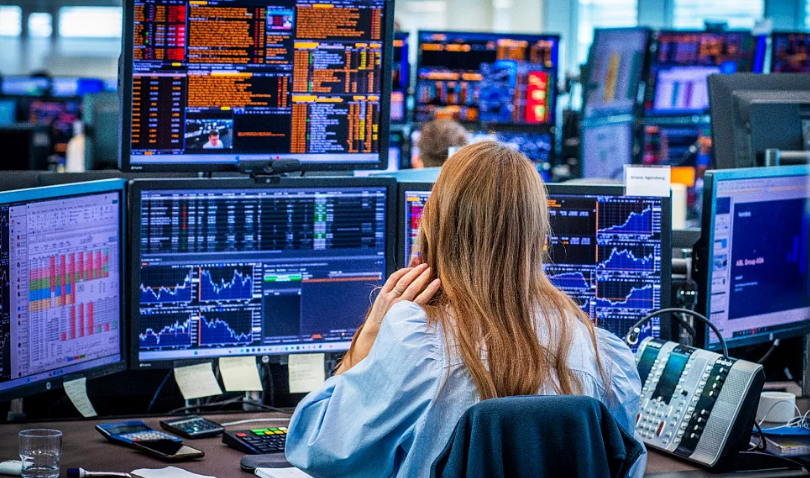Business
Global Central Banks Poised for Key Interest Rate Decisions Amid Market Volatility
Major central banks are set to make crucial interest rate decisions this week, providing key guidance for global financial markets. Investors will closely watch the Federal Reserve’s (Fed) policy outlook, as Wall Street struggles to recover after falling into correction territory.
Global Stock Markets Under Pressure
Stock indices worldwide posted losses last week, driven by escalating trade tensions and risk-off sentiment. While markets saw a slight rebound on Friday, investor focus has now shifted to monetary policy decisions from the Fed, the Bank of Japan (BOJ), the Bank of England (BOE), the Swiss National Bank (SNB), and the People’s Bank of China (PBOC).
Amid economic uncertainty, expectations are rising that major central banks could adopt a more dovish stance. The introduction of new US tariffs under the Trump administration has heightened concerns over global economic stability, increasing the likelihood of more accommodative monetary policies to support market recovery.
Fed Expected to Hold Rates Steady
The Federal Reserve’s upcoming decision is the most anticipated event for financial markets. The Fed has already cut rates by a full percentage point, bringing them to a range of 4.25%–4.5% in 2024. In January, it paused its easing cycle due to persistent inflation and a resilient labor market.
Market expectations suggest that the Fed will maintain rates at current levels until at least June, moving up from the previously anticipated September timeline. Concerns over inflation and weak consumer sentiment—exacerbated by recent US trade policies—are key factors influencing the decision. The US Consumer Price Index (CPI) for February came in lower than expected, reinforcing the possibility of an earlier rate cut.
While the Fed is likely to acknowledge economic risks, it may emphasize the need for sustained evidence of cooling inflation before committing to rate reductions. A dovish stance, often referred to as a “Fed put,” could lead to a strong rebound in US stock markets, weaken the US dollar, and boost major currencies like the euro.
BOE to Keep Rates Unchanged
The Bank of England is expected to maintain its interest rate at 4.5% this week, following a surge in inflation in January. However, swap market pricing suggests potential rate cuts in May and August, accelerating previous forecasts that projected only one reduction this year.
Additionally, increasing defense spending in Europe and Germany’s fiscal reforms could influence the European Central Bank (ECB) to continue loosening its monetary policy, prompting the BOE to follow suit.
The British pound has strengthened against the US dollar, mirroring the euro’s rally. However, analysts warn of potential overvaluation, raising the risk of a near-term correction.
BOJ to Pause Rate Hikes
The Bank of Japan is also expected to hold its policy rate at 0.5% this week, pausing a tightening cycle that began in March 2024. Despite raising rates three times in the past year, BOJ Governor Kazuo Ueda may express concerns over the impact of higher borrowing costs amid global trade uncertainties.
The Japanese yen has surged this year, benefiting from its safe-haven status and BOJ’s policy actions. While Japan’s core CPI stood at 3.2% in January, stubborn inflation is unlikely to alter expectations that the BOJ will slow its rate hikes in response to ongoing trade tensions.
SNB to Cut Rates Again
The Swiss National Bank is widely expected to lower interest rates by 25 basis points to 0.25%, marking its fifth consecutive rate cut since March 2024. The SNB was the first major central bank to initiate an easing cycle, citing cooling inflation and slowing economic growth. However, this could be the final cut in the current cycle, as the bank is unlikely to return to negative interest rates.
PBOC to Maintain Lending Rates
The People’s Bank of China is expected to keep its key lending rates unchanged at 3.1% (1-year loan prime rate) and 3.6% (5-year loan prime rate). However, amid rising trade tensions with the US, Beijing is anticipated to roll out further stimulus measures to bolster economic growth.
During its annual policy meeting, the Chinese government set its GDP growth target at 5% and increased its deficit level to a three-decade high of 4%. Key economic indicators—including industrial production, retail sales, and fixed asset investment—are set to be released this week, offering further insight into the trajectory of China’s economy.
Outlook: Central Banks to Guide Market Sentiment
As central banks prepare to announce their decisions, investors will closely analyze policy statements for indications of future rate moves. A dovish shift from the Fed or other central banks could provide much-needed relief to financial markets, while any hawkish signals may fuel further volatility. With economic uncertainty looming, global markets remain on edge as they await central bank guidance.
Business
Amazon Expands Job Creation in Europe’s High-Unemployment Regions, Invests Billions in Cloud and Infrastructure

Amazon has announced significant investments aimed at driving job growth across Europe’s high-unemployment regions, as part of its broader economic impact strategy. The announcement coincides with the release of the company’s 2024 Europe Impact Report, which revealed Amazon contributed over €41 billion to Europe’s GDP, including €29 billion to the EU27 alone.
The figure is comparable to the entire GDP of Latvia, underscoring Amazon’s growing footprint across the continent. “Our economic impact in Europe goes far beyond the numbers,” said Mariangela Marseglia, Vice President of Amazon Stores EU. “We’re creating opportunities where they’re needed most, supporting local economies, and helping to revitalize communities across the continent.”
Amazon currently employs over 150,000 people across the EU, with more than 90,000 jobs located in areas suffering from above-average unemployment, according to Eurostat. One of the most striking examples is in France’s Hauts-de-France region, where unemployment is 8.7%. There, Amazon has created over 6,000 jobs in the past decade, including 2,600 permanent roles at its Lauwin-Planque fulfillment center.
A recent survey revealed 71% of locals view Amazon’s presence positively, and 94% highlight job creation as a key benefit. Research by Ipsos further supports this trend, showing that 81% of residents near Amazon logistics centers have seen job opportunities increase. More than half report financial improvements that influence long-term life decisions like homeownership or starting a family.
Amazon has also confirmed it does not use zero-hour contracts in any European countries where they are legally permitted, maintaining consistent employment standards across the region.
In terms of long-term investments, Amazon poured over €55 billion into infrastructure and workforce development across Europe in 2024 alone, with €38 billion going to EU member states. Since 2010, total investment has surpassed €320 billion.
Future plans heavily involve Amazon Web Services (AWS), which continues to expand across major European tech hubs. In Germany, Amazon plans to invest €8.8 billion in Frankfurt through 2026, supporting 15,200 jobs and contributing €15.4 billion to the country’s GDP. In the UK, an £8 billion (€9.5 billion) investment will support 14,000 jobs annually through 2028. France is set to benefit from €6 billion in cloud infrastructure investment by 2031, projected to generate €16.8 billion in GDP and support over 5,200 jobs annually.
As Amazon diversifies its European operations, these strategic investments aim to foster employment, boost regional economies, and solidify its presence as a key driver of growth and innovation across the continent.
Business
European Steel Stocks Slide as Trump Tariff Hike Boosts U.S. Rivals

Shares of leading European steel producers dipped on Tuesday as markets reacted to former U.S. President Donald Trump’s plans to double tariffs on steel and aluminium imports, escalating concerns of renewed global trade tensions.
Trump’s proposal, which would increase existing tariffs from 25% to 50%, is set to take effect on June 4. The move has already jolted steel markets, sending European steel stocks lower while fueling gains among American producers. Trump defended the decision on his social media platform, Truth Social, declaring the measure a boost for U.S. industry: “Our steel and aluminum industries are coming back like never before. This will be yet another BIG jolt of great news for our wonderful steel and aluminum workers.”
European investors appeared less optimistic. German steelmaker Thyssenkrupp saw its shares fall 0.5% on the Frankfurt Stock Exchange on Tuesday, while Salzgitter AG slipped 0.4%. ArcelorMittal, one of the world’s largest steel manufacturers, dropped 1.1% on the Euronext Amsterdam. Austria’s Voestalpine AG also registered a 0.8% decline in Vienna.
Conversely, U.S. steel stocks rallied sharply following the announcement. Cleveland-Cliffs surged 23.2%, while Nucor and Steel Dynamics rose 10.1% and 10.3% respectively by Monday’s close, as investors bet on improved prospects for domestic producers shielded from international competition.
Despite the short-term boost for U.S. steel firms, the tariff hike has sparked fresh concerns about the broader economic consequences. Economists warn that the protectionist approach could backfire, raising costs for U.S. industries that rely heavily on imported aluminium and steel — particularly in the automotive and construction sectors.
Felix Tintelnot, professor of economics at Duke University, said the uncertainty surrounding such policy shifts makes long-term investment risky. “We’re talking about expansion of capacity of heavy industry that comes with significant upfront investments, and no business leader should take heavy upfront investments if they don’t believe that the same policy [will be] there two, three, or four years from now,” he told TIME.
Tintelnot further cautioned against setting trade policies unilaterally, emphasizing the need for a predictable economic framework. “Regardless of whether you’re in favour [of] or against these tariffs, you don’t want the President to just set tax rates arbitrarily, sort of by Executive Order all the time,” he said.
As global markets assess the potential fallout, the European steel industry may be bracing for more volatility, while U.S. manufacturers weigh the longer-term impact of a possibly inflationary policy shift.
Business
European Markets Slide as U.S.-China Tariff Tensions Escalate

European stock markets slipped on Monday afternoon as renewed trade tensions between the U.S. and China unsettled investors, reigniting fears of a prolonged global trade dispute.
By 13:05 CEST, all major European indexes were trading in negative territory. The EURO STOXX 50 had dropped 0.68%, Germany’s DAX was down 0.48%, and France’s CAC 40 had fallen by 0.63%.
The downturn followed comments from Beijing accusing the United States of “severely violating” the terms of their recent trade agreement, prompting concerns of a fresh round of retaliatory measures. Investors were also reacting to U.S. President Donald Trump’s announcement that tariffs on steel and aluminium imports would be doubled from 25% to 50% starting Wednesday.
“Donald Trump has upset markets once again,” said Russ Mould, investment director at AJ Bell, in a note shared with Euronews. “Doubling import taxes on steel and aluminium, and aggravating China once again, mean we face a situation where uncertainty prevails. Trump’s continuous moving of the goalposts is frustrating for businesses, governments, consumers, and investors.”
Market sentiment soured across Europe and Asia, with futures suggesting a similarly weak open for Wall Street later in the day. In response to rising uncertainty, investors turned to safe-haven assets, giving gold a boost.
U.S. Market Outlook Mixed
While U.S. equity markets ended May relatively flat, major indices posted solid gains over the month, lifted by earlier optimism around easing trade tensions. However, that sentiment is now under pressure.
“The latest broadsides from the White House were primarily directed at China and the EU, with both threatening a response in kind to any further tariff hikes,” said Richard Hunter, head of markets at Interactive Investor.
Still, there were some encouraging economic signals. The Federal Reserve’s preferred inflation gauge, the Personal Consumption Expenditures index, came in lower than expected, while consumer sentiment surprised on the upside. Analysts caution, however, that these may be temporary reprieves.
Looking ahead, attention is turning to U.S. non-farm payroll data due at the end of the week. Economists forecast 130,000 new jobs added in May, down from 177,000 the previous month, with unemployment expected to hold at 4.2%.
Despite recent gains, U.S. markets remain fragile. Year-to-date, the Dow Jones is down 0.6%, the Nasdaq 1%, while the S&P 500 has managed a modest 0.5% rise, bolstered in part by strength in large-cap tech stocks.
Asian Markets Also Weigh Trade and Geopolitics
Asian markets also came under pressure. The Hang Seng index fell amid renewed concerns over U.S. tariffs and geopolitical uncertainty stemming from ongoing Russia-Ukraine tensions.
Mainland China’s markets were closed for a public holiday, but investors expect potential losses upon reopening, particularly after recent data showed further contraction in factory activity.
With trade tensions heating up again, global markets are bracing for a volatile start to June.
-

 Business1 year ago
Business1 year agoSaudi Arabia’s Model for Sustainable Aviation Practices
-

 Business1 year ago
Business1 year agoRecent Developments in Small Business Taxes
-

 Politics1 year ago
Politics1 year agoWho was Ebrahim Raisi and his status in Iranian Politics?
-

 Business11 months ago
Business11 months agoCarrectly: Revolutionizing Car Care in Chicago
-

 Business11 months ago
Business11 months agoSaudi Arabia: Foreign Direct Investment Rises by 5.6% in Q1
-

 Technology1 year ago
Technology1 year agoComparing Apple Vision Pro and Meta Quest 3
-

 Politics1 year ago
Politics1 year agoIndonesia and Malaysia Call for Israel’s Compliance with ICJ Ruling on Gaza Offensive
-

 Sports10 months ago
Sports10 months agoKeely Hodgkinson Wins Britain’s First Athletics Gold at Paris Olympics in 800m


























